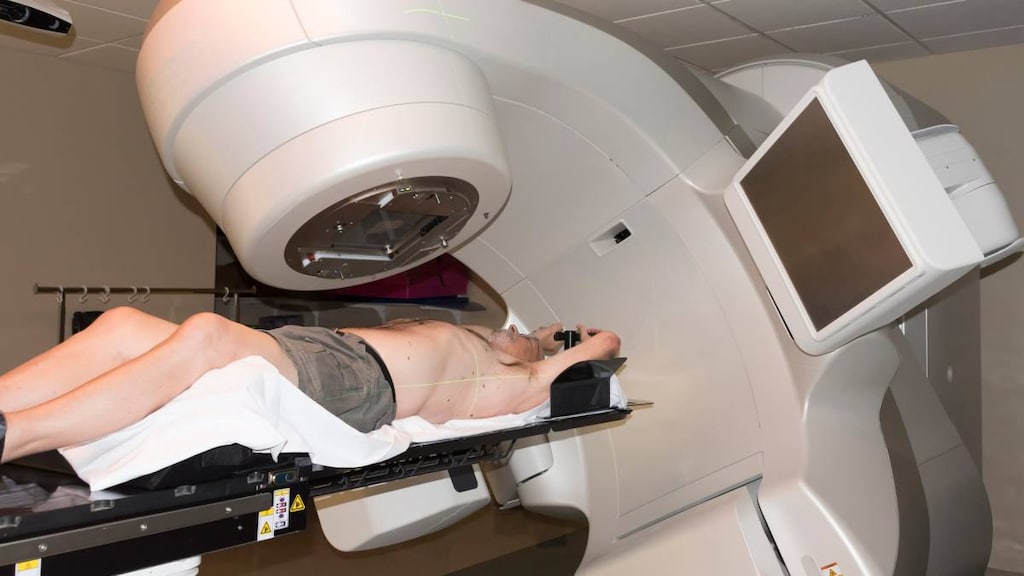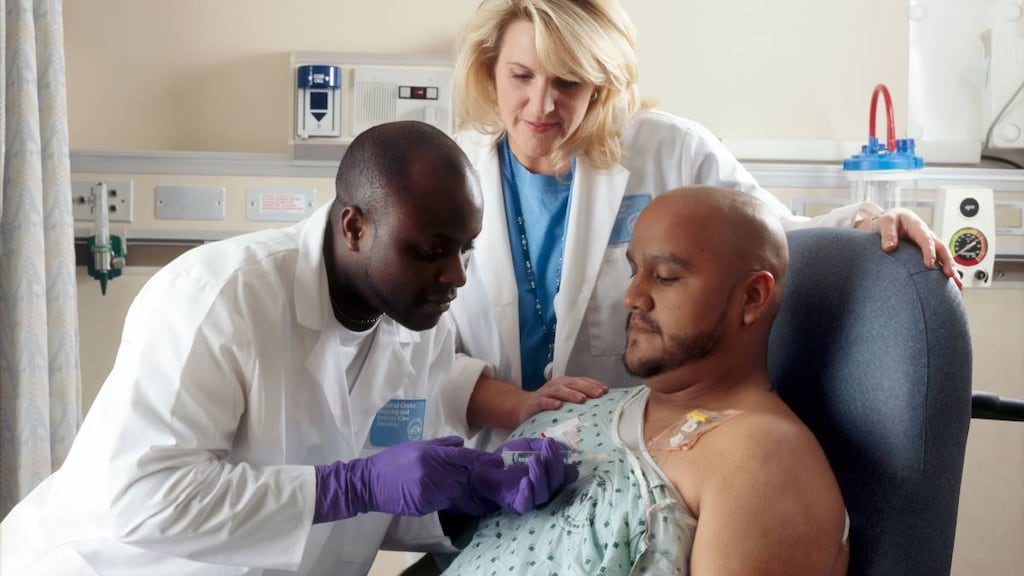Dosage Forms
Excipient information presented when available (limited, particularly for generics); consult specific product labeling.
Suspension, Intravenous [preservative free]:
Provenge: (250 mL)
Pharmacology
Mechanism of Action
Autologous cellular immunotherapy which stimulates an immune response against an antigen (PAP) expressed in most prostate cancer tissues. Peripheral blood is collected (~3 days prior to infusion) from the patient via leukapheresis, from which peripheral blood mononuclear cells (PBMCs) are isolated. Antigen presenting cell (APC) precursors, consisting of CD54-positive cells that include dendritic cells, are isolated from the PBMCs. The APCs are then activated (in vitro) with a recombinant human fusion protein, PAP-GM-CSF (also termed PA2024), composed of an antigen specific for prostate cancer, prostatic acid phosphatase (PAP) linked to granulocyte-macrophage colony-stimulating factor (GM-CSF) and cultured for ~40 hours. The final product, sipuleucel-T, is reinfused into the patient, inducing T-cell immunity to tumors that express PAP.
Use: Labeled Indications
Prostate cancer, metastatic: Treatment of asymptomatic or minimally symptomatic metastatic castrate-resistant (hormone-refractory) prostate cancer.
Contraindications
There are no contraindications listed in the manufacturer’s labeling.
Dosage and Administration
Dosing: Adult
Note: Premedicate with oral acetaminophen 650 mg and an antihistamine (eg, diphenhydramine 50 mg) ~30 minutes prior to infusion. For autologous use only. Do not infuse until confirmation of product release has been received from the company.
Prostate cancer, metastatic: IV: Each dose contains ≥50 million autologous CD54+ cells (obtained through leukapheresis) activated with PAP-GM-CSF; administer doses at ~2-week intervals for a total of 3 doses (Kantoff, 2010). If unable to receive a scheduled infusion, an additional leukapheresis procedure will be necessary prior to continuing a course of treatment.
Dosing: Geriatric
Refer to adult dosing.
Dosing: Adjustment for Toxicity
Acute infusion reaction: Interrupt or slow infusion rate (depending on the severity of infusion reaction); may require acetaminophen, IV H1 and/or H2 antagonists, or low-dose meperidine to manage acute symptoms.
Reconstitution
Sipuleucel-T will arrive as a prepared patient-specific 250 mL suspension in lactated Ringer’s injection. Contents may appear clear to opaque and will be a white to red color, including shades of off-white, cream, light yellow, and orange. If clumps or clots are present, gently mix to resuspend. Do not administer if the bag leaks during handling, is damaged, or if clumps remain.
Administration
IV: For autologous use only; the identity of the patient must be matched to the patient identifiers on the infusion bag and on the “Final Product Disposition Notification” prior to infusion. Do not infuse until confirmation of product release is received from the company. Keep the sealed infusion bag in the insulated polyurethane container inside the shipping box until ready for administration. Prior to infusion, inspect bag for signs of leaks (do not administer if leaking) or damage. Gently mix to resuspend contents; inspect for clumps or clotting; small clumps should disperse with the gentle mixing; do not administer if clumps remain. Infusion must begin prior to the expiration date and time; do NOT infuse if expired.
For IV infusion only. Infuse over ~60 minutes; infuse the entire contents of the bag. Do NOT use a cell filter for infusion. For acute infusion reaction, interrupt or slow infusion rate (depending on the severity of infusion reaction); may require acetaminophen, IV H1 and/or H2 antagonists, or low-dose meperidine to manage acute symptoms. If infusion is interrupted, keep infusion bag at room temperature; do not resume if bag is retained at room temperature for >3 hours. Observe patient for at least 30 minutes after infusion.
Storage
Do not remove the infusion bag from the insulated polyurethane container within the shipping box until administration (do not remove the insulated container from the shipping box, or open the lid of the insulated container, until administration). Product may only remain at room temperature for ≤3 hours once removed from shipping container; after removal from shipping container, do not return product to container. Infusion must begin prior to product expiration.
Drug Interactions
Immunosuppressants: May diminish the therapeutic effect of Sipuleucel-T. Management: Evaluate patients to see if it is medically appropriate to reduce or discontinue therapy with immunosuppressants prior to initiating sipuleucel-T therapy. Exceptions: Cytarabine (Liposomal). Consider therapy modification
Adverse Reactions
Note: Initial infusion-related events usually present within the first 24 hours after administration.
>10%:
Central nervous system: Chills (53%; grades ≥3: 2%), fatigue (41%; grades ≥3: 1%), headache (18%; grades ≥3: <1%), dizziness (12%; grades ≥3: <1%), pain (12%)
Gastrointestinal: Nausea (22%; grades ≥3: <1%), vomiting (13% grades ≥3: <1%), constipation (12%; grades ≥3: <1%)
Hematologic: Anemia (13%)
Hypersensitivity: Severe infusion related reaction (71%; grade 3: 4%)
Neuromuscular & skeletal: Back pain (30%; grades ≥3: 3%), myalgia (12%; grades ≥3: <1%), weakness (11%; grades ≥3: 1%)
Miscellaneous: Fever (31%; grades ≥3: 1%), citrate toxicity (15%)
1% to 10%:
Cardiovascular: Hypertension (8% grades ≥3: <1%), hemorrhagic stroke (4%)
Dermatologic: Diaphoresis (5%; grades ≥3: <1%), skin rash (5%)
Gastrointestinal: Anorexia (7%), acute ischemic stroke (4%)
Genitourinary: Hematuria (8%)
Neuromuscular & skeletal: Musculoskeletal pain (9%; grades ≥3: <1%), muscle spasm (8%; grades ≥3: <1%), neck pain (6%), tremor (5%)
Renal: Hematuria (8%)
Respiratory: Flu-like symptoms (10%), dyspnea (9%; grades ≥3: 2%)
<1%, postmarketing, and/or case reports: Cerebrovascular accident, eosinophilia, hypotension, myasthenia gravis, myocardial infarction, myositis, paresthesia (grades ≥3), pulmonary embolism, rhabdomyolysis, sepsis, syncope, transient ischemic attacks, tumor flare, venous thrombosis
Warnings/Precautions
Concerns related to adverse effects:
- Infusion reaction: Acute infusion reactions may occur within 1 day of infusion and are usually mild or moderate for most patients; the incidence of severe reaction may be higher with the second infusion, while the third infusion is associated with a decrease in the incidence of severe reactions. Premedication with oral acetaminophen and diphenhydramine is recommended. Depending on the severity of the infusion reaction, interrupt or slow infusion rate; in clinical trials, acetaminophen, intravenous (IV) H1 and/or H2 antagonists, and low-dose meperidine were used to manage acute symptoms. Symptoms of acute infusion reaction may include chills, rigor, fever, bronchospasm, dyspnea, hypoxia, hypertension, tachycardia, syncope, hypotension, joint or muscle aches, nausea, vomiting, dizziness, fatigue, headache, and weakness; fever and chills usually resolved within 2 days. Observe patient for at least 30 minutes after infusion.
- Thromboembolic events: Deep venous thrombosis (DVT) and pulmonary embolism occurred following sipuleucel-T infusion (postmarketing reports), usually in patients with multiple risk factors for thromboembolism. Use with caution in patients at risk for thromboembolic events.
- Vascular disorders: Cerebrovascular (hemorrhagic and ischemic stroke) and cardiovascular events (myocardial infarction [MI]) have occurred; transient ischemic attacks have been reported following infusion (postmarketing reports). Such events usually occurred in patients with multiple risk factors for cerebrovascular or cardiovascular incidents.
Disease-related concerns:
- Cardiovascular disease: Closely monitor during infusion in patients with cardiac conditions.
- Pulmonary disease: Closely monitor during infusion in patients with pulmonary conditions.
Concurrent drug therapy issues:
- Androgen deprivation therapy: In clinical trials, patients who had androgen deprivation therapy without prior bilateral orchiectomy were continued on gonadal suppression with a luteinizing hormone-releasing hormone (LHRH) agonist (Higano, 2009).
- Chemotherapy: Concurrent use with chemotherapy has not been studied.
- Immunosuppressive therapy: Concurrent use with immunosuppressives (eg, corticosteroids) has not been studied; may alter the efficacy and/or safety of sipuleucel-T. Carefully evaluate patients for appropriateness of reducing or discontinuing immunosuppressive agents prior to treatment.
Other warnings/precautions:
- Appropriate use: For autologous use only. Patient identity must be matched to the patient identifiers on the infusion bag and on the Final Product Disposition Notification (provided by manufacturer) prior to infusion. Confirmation of product release must be received from the manufacturer prior to infusion.
- Handling precautions: Apply universal precautions for product handling. Sipuleucel-T is not routinely tested for transmissible infectious diseases; patient-specific leukapheresis collection and activated product may have a risk for infectious disease transmission.
- Sterility testing: Preliminary sterility testing is done based on a 2-day incubation period. Final (7-day incubation) testing is not available until after administration; physicians will be notified if 7-day sterility tests are positive for microbial contamination.
- Treatment delays: If unable to receive a scheduled reinfusion, an additional leukapheresis procedure may be required; advise patients of this possibility before treatment initiation.
Monitoring Parameters
Monitor for infusion reaction during and for at least 30 minutes after infusion; monitor closely during infusion for patients with cardiovascular and pulmonary disease; monitor for thromboembolic and vascular events.
Pregnancy
Pregnancy Considerations
Animal reproduction studies have not been conducted. Not indicated for use in women.
Patient Education
- Discuss specific use of drug and side effects with patient as it relates to treatment. (HCAHPS: During this hospital stay, were you given any medicine that you had not taken before? Before giving you any new medicine, how often did hospital staff tell you what the medicine was for? How often did hospital staff describe possible side effects in a way you could understand?)
- Patient may experience constipation, lack of appetite, bone pain, common cold symptoms, trouble sleeping, neck pain, weight loss, sweating a lot, tremor, muscle spasm, diarrhea, flushing, joint pain, or back pain. Have patient report immediately to prescriber signs of infection, signs of a urinary tract infection (blood in the urine, burning or painful urination, passing a lot of urine, fever, lower abdominal pain, or pelvic pain), signs of severe cerebrovascular disease (change in strength on one side is greater than the other, difficulty speaking or thinking, change in balance, or vision changes), signs of blood clots (numbness or weakness on one side of the body; pain, redness, tenderness, warmth, or swelling in the arms or legs; change in color of an arm or leg; chest pain; shortness of breath; fast heartbeat; or coughing up blood), burning or numbness feeling, shortness of breath, passing out, dizziness, fast heartbeat, chest pain, abnormal heartbeat, swelling of arms or legs, flu-like symptoms, severe loss of strength and energy, severe nausea, vomiting, headache, muscle pain, or injection site pain, edema, or irritation (HCAHPS).
- Educate patient about signs of a significant reaction (eg, wheezing; chest tightness; fever; itching; bad cough; blue skin color; seizures; or swelling of face, lips, tongue, or throat). Note: This is not a comprehensive list of all side effects. Patient should consult prescriber for additional questions.
Intended Use and Disclaimer: Should not be printed and given to patients. This information is intended to serve as a concise initial reference for health care professionals to use when discussing medications with a patient. You must ultimately rely on your own discretion, experience, and judgment in diagnosing, treating, and advising patients.




